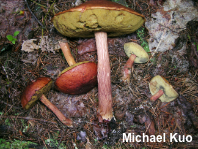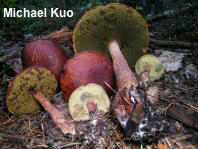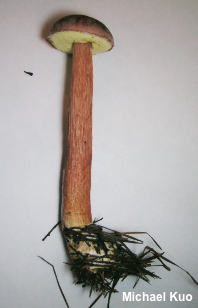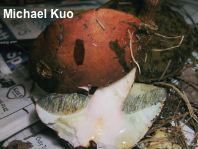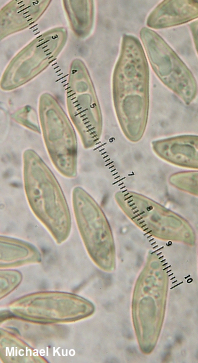| Major Groups > Boletes > Aureoboletus projectellus |

|
Aureoboletus projectellus [ Basidiomycota > Boletales > Boletaceae > Aureoboletus . . . ] by Michael Kuo Aureoboletus projectellus associates with various pines (species of Pinus, with bundled needles) in eastern North America from Canada to Mexico, and can be identified by its proportionally long, ridged stem with copious white basal mycelium, and its reddish brown to brown cap with a projecting sterile margin (for which the species is named). The ridges on the stem are initially shallow, but by maturity they are deep and sometimes nearly reticulate. Aureoboletus russellii is somewhat similar, but its stem is lacerated-reticulate, rather than ridged, and it is more likely to be found under hardwoods than conifers. Additionally, under the microscope, Aureoboletus russellii features very different spores. Boletus projectellus, Boletellus projectellus, and Ceriomyces projectellus are synonyms. Description: Ecology: Mycorrhizal with a variety of pines (species of Pinus, with bundled needles); growing scattered or gregariously; summer and fall; widely distributed in eastern North America from the northeast to the upper Midwest and the southeastern United States, through Texas into Mexico. The illustrated and described collections are from Michigan and Georgia. Cap: 4–14 cm; convex, becoming broadly convex; tacky to sticky; bald; dark brown to dark reddish brown or purplish brown; the margin with an overhanging, sterile portion projecting 1–3 mm. Pore Surface: Pale yellow, becoming olive yellow and eventually dirty brownish olive; depressed at the stem; not bruising—or, occasionally, bruising blue; 1–2 pores per mm at maturity; tubes to 1.5 cm deep. Stem: 6–17 cm long; 1–3 cm thick; equal, or with a slightly swollen base; shallowly longitudinally ridged at first, becoming widely and prominently ridged or nearly reticulate with maturity; slightly sticky when fresh; pinkish brown to brown; basal mycelium white and prominent. Flesh: White to pale yellowish or pinkish in places; not staining on exposure. Odor and Taste: Not distinctive. Chemical Reactions: Ammonia black on cap; grayish on flesh. KOH mahogany on cap; yellowish on flesh. Iron salts gray on cap; greenish on flesh. Spore Print: Olive. Microscopic Features: Spores 19–29 x 6–10 µm; fusiform; smooth; walls 05.–2 µm thick; golden in KOH. Hymenial cystidia 35–70 x 7.5–10 µm; cylindric to fusiform or lageniform; smooth; thin-walled; hyaline to yellow in KOH. Pileipellis a collapsing ixotrichoderm; elements 7.5–12.5 µm wide, smooth or slightly encrusted, hyaline to golden in KOH; terminal cells cylindric with subclavate or slightly irregular apices. REFERENCES: (Murrill, 1938) Halling, 2015. (Coker & Beers, 1943; Snell & Dick, 1961; Snell & Dick, 1970; Smith & Thiers, 1971; Grund & Harrison, 1976; Smith, Smith & Weber, 1981; Phillips, 1991; Both, 1993; Bessette, Roody & Bessette, 2000; Roody, 2003; Binder & Hibbett, 2006; Nuhn et al., 2013; Kuo & Methven, 2014; Halling et al., 2015; Bessette, Roody & Bessette, 2016; Baroni, 2017.) Herb. Kuo 10170909, 09111014. This site contains no information about the edibility or toxicity of mushrooms. |
© MushroomExpert.Com |
|
Cite this page as: Kuo, M. (2019, November). Aureoboletus projectellus. Retrieved from the MushroomExpert.Com Web site: http://www.mushroomexpert.com/aureoboletus_projectellus.html |
